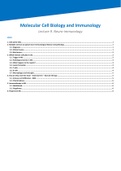Class notes
Lecture 9. The immune system in the brain (neuro-immunology) (AM_470656)
- Course
- Institution
- Book
Information on immune cells in the CNS, multiple sclerosis as an example, immune cell filtration through the blood-brain barrier, and immunotherapy in multiple sclerosis.
[Show more]




